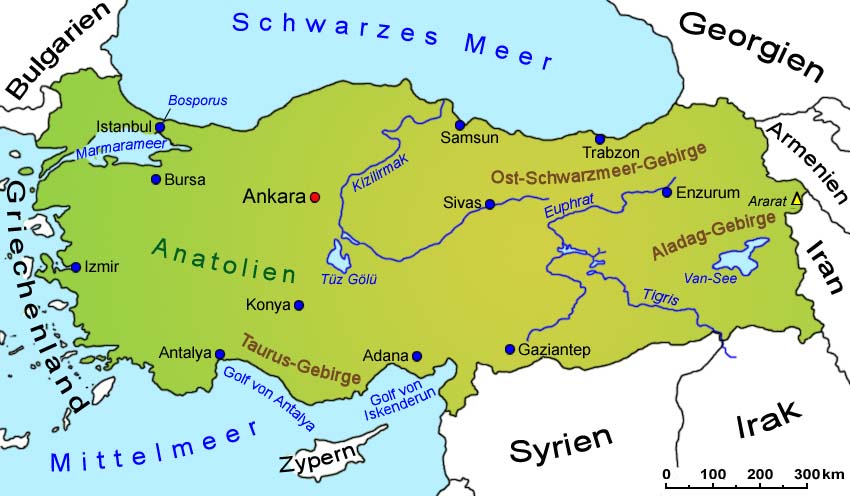Name for wine (white = beyaz, red = kirmizi) in Turkey; see there.
Turkey
The Republic of Turkey (Türkiye in Turkish) with its capital Ankara covers 783,562 km². It stretches across the two continents of Asia and Europe. The Asian part Anatolia makes up 97% of the country, the European part Eastern Thrace in the far north-west of the country only 3%, where the main part of Istanbul is located. The state borders Greece and Bulgaria to the north-west, Georgia, Armenia and Azerbaijan to the north-east, Iran to the east and Iraq and Syria to the south-east. The politically divided island of Cyprus with the Republic of Cyprus and the internationally unrecognised Turkish Republic of Northern Cyprus lies 70 kilometres from the south coast. The Greek islands of Chios, Kos, Symi and Rhodes lie close to the Turkish mainland in the west. Turkey is divided geographically into seven areas or regions.

History
The country has an ancient wine-growing tradition, as there were already cultivated vineyards in Anatolia, in the Transcaucasia region (which is considered the cradle of wine culture with Mesopotamia and overlaps with it to a large extent) and on the coast of the Caspian Sea at least as early as the 4th millennium BC. During excavations in the city of Catal Hüyük, built in the 7th millennium BC, depictions were found which suggest that wine was already being produced at this time. An ancestor of the Kalecik Karasi grape variety was supposedly known to the Hittites as early as ~1,500 BC, according to a hypothesis that cannot of course be verified. According to the latest research, the origin of the cultivated grapevine and viticulture could lie in south-east Anatolia. Close to the border with Armenia lies the famous Mount Ararat, where, according to the Bible, Noah landed with his ark after the Flood and "became a winegrower", although this should not be taken as "proof".
Viticulture in modern times
The Islamisation of the country and the associated ban on alcohol led to the first turning point in viticulture in the 8th century. During the Ottoman period (1300-1920), only Christian minorities such as Greeks and Armenians were allowed to produce wine, subject to high taxes. In the Tanzimat period, viticulture was revived from the middle of the 19th century and exports rose to 30 million litres a year by the beginning of the 20th century due to the phylloxera catastrophe in Europe and the resulting shortage of wine. After large areas of land had to be ceded to Greece, among others, at the Peace of Lausanne in 1923 and the majority of the Greek minority, who were important for viticulture, left the...
Voices of our members

The glossary is a monumental achievement and one of the most important contributions to wine knowledge. Of all the encyclopaedias I use on the subject of wine, it is by far the most important. That was the case ten years ago and it hasn't changed since.
Andreas Essl
Autor, Modena